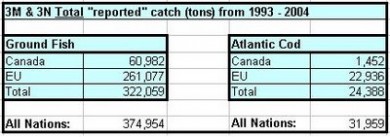In 1992 the government of Canada introduced a moratorium to protect cod stocks that were teetering on the brink of extinction.
This action, directly and indirectly, put over 10% of Newfoundland and Labrador's population out of work in the blink of an eye.
In the 17 years since this supposed ban on cod fishing was introduced, the stocks have failed to make any real progress in growing their numbers and are still in dire peril of total collapse.
The following numbers may shed some light on why this is the case.
All the numbers presented below are based on North West Atlantic Fisheries Organization (NAFO) reported catches up to, and including, 2004.
Numbers after that point are not as easily accessible but are being gathered for potential future reports.
No data is available on the level of “under reported” or “non-reported” catches in these areas so the following only includes what has been officially reported to NAFO.
For those who are unfamiliar with the location of specific NAFO fishing zones, the nose and tail of the Grand Banks and the Flemish Cap, which are considered to be crucial breeding grounds or nurseries for Atlantic Cod, fall almost entirely within NAFO Zones 3M and 3N.




Note: The last set of numbers are some of the most interesting.
If you assume an average weight of 7 pounds per fish, which is probably generous due to the state of current stocks, these numbers represent about 200 million Atlantic Cod reported as caught after the 1992 moratorium was introduced.
As large as that number appears, nobody knows how many more cod have actually been caught and sold on world markets.



 Note: The last set of numbers are some of the most interesting.
If you assume an average weight of 7 pounds per fish, which is probably generous due to the state of current stocks, these numbers represent about 200 million Atlantic Cod reported as caught after the 1992 moratorium was introduced.
As large as that number appears, nobody knows how many more cod have actually been caught and sold on world markets.
Note: The last set of numbers are some of the most interesting.
If you assume an average weight of 7 pounds per fish, which is probably generous due to the state of current stocks, these numbers represent about 200 million Atlantic Cod reported as caught after the 1992 moratorium was introduced.
As large as that number appears, nobody knows how many more cod have actually been caught and sold on world markets.